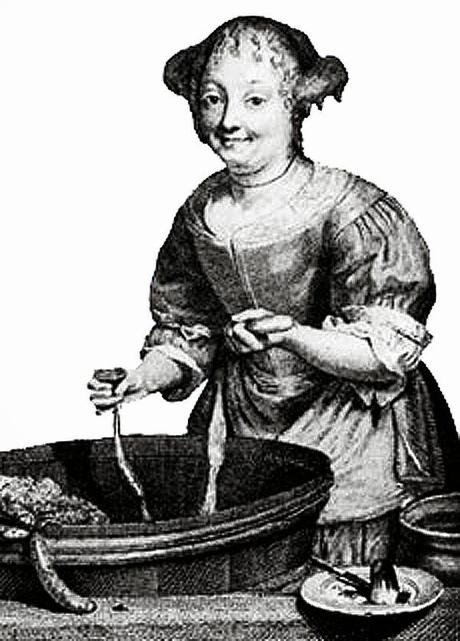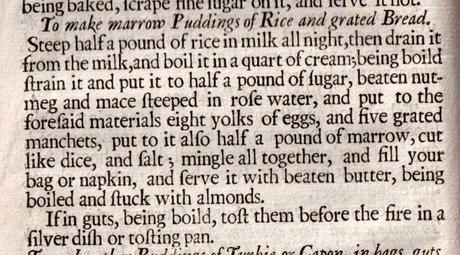
Rice puddings boiled in skins made from Gervase Markham's 1615 recipe (see below)
When I was a child, I frequently heard the popular idiom, 'he could n't knock the skin off a rice pudding' - usually being applied to someone who had behaved in a cowardly way. The skin referred to, was of course that delicious, caramelised, not-quite-burnt crust that forms on a British oven baked rice pudding. Many of us, including me, are of the opinion that this nutmeg-scented membrane is the choicest bit of this once ubiquitous and homely pud. But in the far distant past the skin of a rice pudding had a more literal meaning. During Shakespeare's lifetime, rice puddings were usually made in lengths of intestine, what we would now call sausage skins - they were literally cooked in skins. So the earliest recipes for rice pudding indicate that it was originally one of the vast genus of true boiled puddings made in animal guts that were popular and widespread during the early modern period and beyond. Some of its first cousins, like mealy puddings, white puddings and black puddings still survive to this day. The recipe in black letter below is for a rice pudding of this kind published a year before Shakespeare died, in which a mixture of boiled rice and other ingredients is stuffed into 'scoured guts' before they are parboiled.
From John Murrell, A Newe Booke of Cookery. (London: 1615).
Murrell's recipe stands out as it calls for barberries, as well as the more usual currants included in puddings of this kind. Nowadays barberries, the fruits of the British native Berberis vulgaris L. are hardly used at all in British cookery, but were immensely popular at this time for their pleasant acidic flavor and stunning red color. They were frequently used as a striking garnish and were the basis of a number of sweetmeats and preserves. Another important role they enjoyed was to add acidity as well as color to forcemeats, pie fillings and in this case - puddings.
The bright red fruits of Berberis vulgaris L.

Early pudding makers used little funnels to fill the lengths of intestine, a procedure that is beautifully and amusingly illustrated in the seventeenth century engraving below. Although one can get good at it with practice, this is a slow and laborious process. An improvement came with the introduction of the pudding forcers, a kind of syringe which the length of gut could be stretched over. But even these were hard to use, though considerably faster than the funnels.

How a pudding funnel was used at this period - slow work!

A long length of gut was massaged over the neck of the pudding funnel.

The pudding mixture was then pushed through the funnel into the gut with a finge

A pudding forcer made an easier job of this messy and slow business.

A rare contemporary engraved portrait of Gervase Markham, equestrian, playwright and author of books on countless subjects. Like Murrell, Markham published a recipe for Rice puddings in skins in 1615 in his celebrated recipe collection, The English Housewife (London: 1615). Here it is below.

Gervase Markham's recipe for rice puddings, published the same year as Murrell's. By 'farms' is meant 'forms, a common term for guts.
I made both Murrell's and Markham's rice puddings a few days ago for a dinner celebrating the 450th anniversity of Shakespeare's birthday. Variant recipes for rice puddings continued to be published in the later seventeenth century, that below coming from Robert May's The Accomplisht Cook (London: 1660), with a specific direction to tie the ends of the guts together, making a ring shaped pudding. This incarnation is flavoured generously with a whole pint of rose-water!
From Robert May's The Accomplisht Cook (London: 1660)
Another of May's rice pudding recipes instructs us to boil a very similar preparation in a bag or napkin. However, as an afterthought, he explains that when you make rice puddings in guts, you should toast them before the fire 'in a silver dish or tosting pan'. This makes much more sense of Murrell's 1615 recipe, who instructs us to parboil the puddings, indicating that there was a second cooking process to follow. Toasting or broiling them afterwards cooks the puddings so they end up looking like grilled sausages.
From Robert May's The Accomplisht Cook (London: 1660)

Robert May's marrow puddings of rice and grated bread simmer for about quarter and hour. Like all skin puddings, the forms must not be tightly filled as the contents will swell and burst the skins. They must also be pricked to release any air before they arevery gently poached in the simmering, not boiling, water.

Before the puddings are toasted in front of the fire, I find that hanging them up to dry out for a day really improves them.

A toasted rice pudding
Rice puddings like this survived into the eighteenth century, as witness this recipe from the Yorkshire cookery author Elizabeth Moxon.
Rice puddings boiled in skins from Elizabeth Moxon (Leeds: 1749). Elizabeth tells us to 'cree' the rice in milk. This interesting word is from the French crever, to burst or split. To cree rice or frumenty was to boil it until it burst and came to a soft mash. However, it could also mean to crush, mill or kibble. The wheat or barley used for making frumenty was 'creed' or crushed in a 'creeing trough'.
